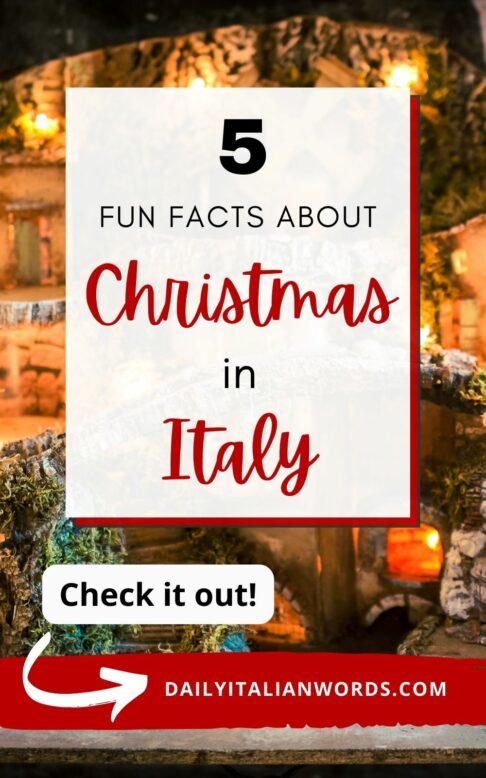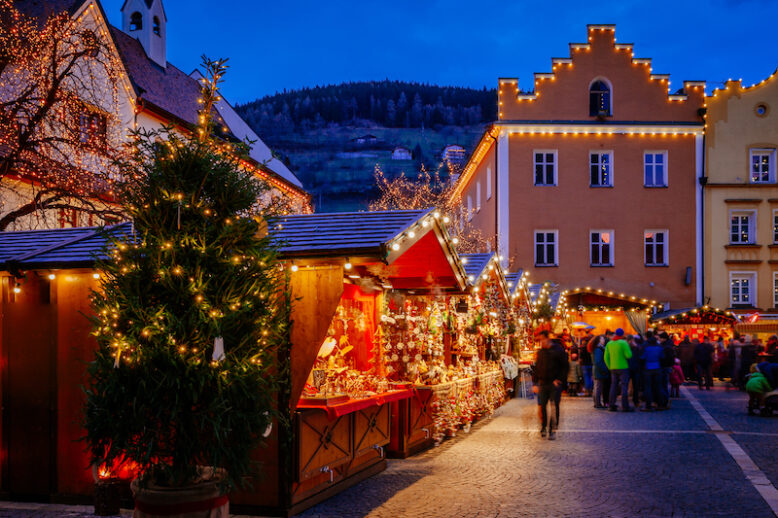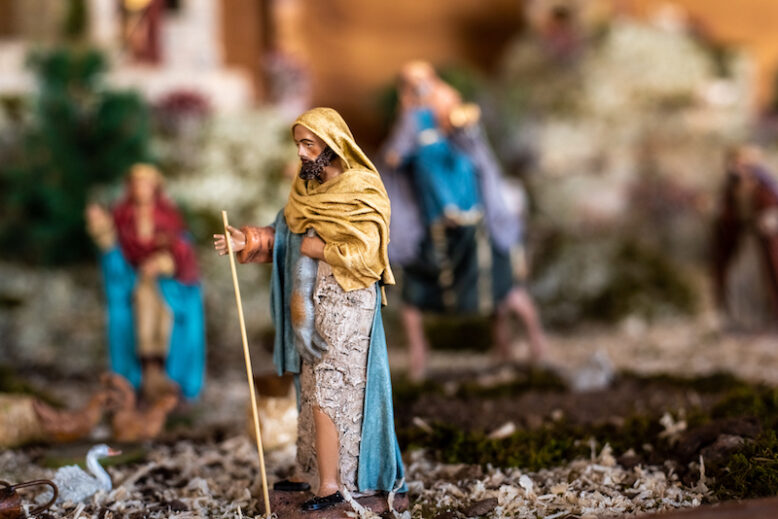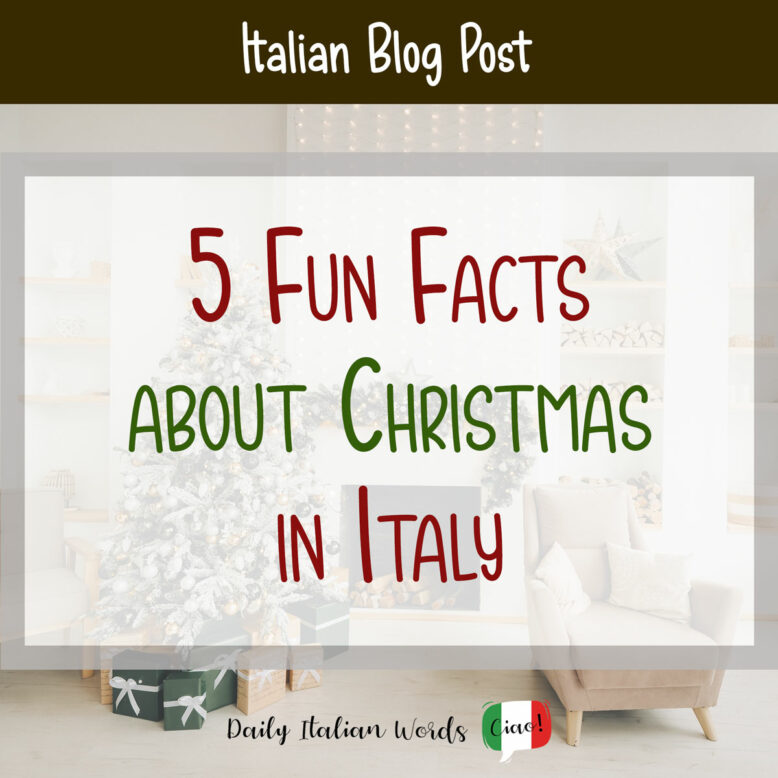Christmas is a holiday of Christian origin which commemorates the birth of Jesus in Bethlehem. The holiday period has expanded over time to more than 14 days in Italy. Many traditions and cultural events exist to celebrate Christmas and in some cases they may seem to be outside the mainstream. Let’s take a look in detail at five of the most unique customs of the Boot.
Il Natale è una festività di origine cristiana che ricorda la natività di Gesù a Betlemme. Il periodo di festa con il tempo si è dilatato fino a raggiungere oltre i 14 giorni in Italia. Le tradizioni e gli eventi culturali per celebrare il Natale sono molteplici e in alcuni casi possono sembrare un po’ fuori dal coro. Ma vediamo nel dettaglio cinque delle usanze più particolari dello Stivale.
First of all, on Christmas Eve, Santa Claus is thought to come down the chimney to bring gifts to the most deserving children. In reality, they all receive them, along with the odd piece of coal on occasion. (But don’t worry, it isn’t really coal, it’s actually just black coloured sugar!)
Prima di tutto, la notte della vigilia si pensa che giunga Babbo Natale giù per il camino a portare doni ai bambini più meritevoli. In realtà sono tutti a riceverli, anche se a volte con qualche pezzo di carbone. (Ma tranquilli, è solo apparenza, nel concreto è solo zucchero colorato di nero!)
Santa delivers presents from house to house, and often stays for a few minutes as families leave him a drink or something to eat to say “thank you” – sometimes even a shot of grappa! After the small banquet, St. Nicholas resumes his journey, wishing everyone a Merry Christmas.
Babbo Natale consegna i regali, casa per casa, e spesso si trattiene per qualche minuto poiché le famiglie gli lasciano una bevanda o qualcosa da mangiare per ringraziare – a volte anche un grappino. Terminato il piccolo banchetto, San Nicola riprende il suo viaggio, augurando a tutti un felice e Buon Natale.
Tradition dictates that on the morning of the 25th, the presents under the Christmas tree are unwrapped, but customs vary from region to region and in some cases, the gifts are unwrapped on December 23rd or 24th. In the meantime, Christmas celebrations have been in full swing for quite some time, and here’s what you can expect.
La tradizione vuole che il 25 mattina si scartino i regali sotto l’albero di Natale. Ma le usanze cambiano di regione in regione e in alcune di esse i regali si scartano il 23 o il 24 di dicembre. Nel frattempo, le feste di Natale sono già iniziate da un bel pezzo ed ecco come.

This article is part of our Bilingual Blog series, where we share useful information and tips about non-language related aspects of Italian culture such as food, music, travel and more. These articles have been written in Italian and English to give our readers the opportunity to improve their reading skills whilst learning something new about Italy.
1. The Immaculate Conception
L’Immacolata Concezione
In Italy it is customary to put up the Christmas tree on December 8th, on the occasion of the feast of the Immaculate Conception. This day is a holiday and everyone stays at home to welcome the Christmas season.
In Italia è consuetudine montare l’albero di Natale l’8 dicembre, in occorrenza della festa dell’Immacolata Concezione. Il giorno è festivo e tutti sono a casa per dare il benvenuto al periodo natalizio.
To complete the scene, the most faithful or passionate show off their artistic flair by creating Nativity scenes of all shapes and sizes, sometimes in impressive detail. In fact, the Nativity carries great importance in the Italian tradition and is present in almost every house in the country.
Per completare la scena, soprattutto i più fedeli o appassionati, sfoggiano il loro estro artistico per creare presepi di ogni forma e con dettagli talvolta impressionanti. La natività ha infatti una grande importanza nella tradizione italiana ed è presente in quasi ogni casa del Paese.
2. The Bagpipers
Gli zampognari
In the past, it was the bagpipers who kicked off the festivities. In Naples, for example, they began to play their sweet melodies in the city as early as the end of November. The pipers belong to an ancient tradition that today is limited mainly to central and southern Italy, but is also recognised throughout the entire peninsula.
A dare il via alle festività in passato erano gli zampognari che a Napoli ad esempio iniziavano a suonare e portare armonia in città già dalla fine di novembre. Gli zampognari appartengono ad una tradizione antichissima che oggi è vissuta prevalentemente nel centro e nel meridione d’Italia, ma che riguarda l’intera penisola.
Men in Scottish kilts and sheepskin coats pay homage by announcing the Novena of the Annunciation of Mary. The instrument they play is the distinctive bagpipe, a variation on today’s Scottish bagpipe.
Uomini in kilt scozzese e con una pelliccia di pecora rendono omaggio annunciando la Novena dell’annunciazione di Maria. Lo strumento che suonano è la caratteristica zampogna, una variazione dell’odierna cornamusa scozzese.
The history of bagpipers has its roots in Classical Greek culture, specifically the god Pan and his mythical flute. Over time, and in particular with the arrival of the Romans and the emperor Nero, the Greek tradition ended up being absorbed by Christianity, thus becoming a reference for the sacred events of the Church.
La storia degli zampognari affonda le sue radici in terra ellenica con il dio Pan e il suo mitico flauto. Con il tempo, e in particolare con i romani e l’imperatore Nerone, la tradizione greca finì per essere assorbita dal Cristianesimo e diventare quindi un richiamo per gli avvenimenti sacri della Chiesa.
3. From the Immaculate Conception to the Epiphany
Dall’Immacolata Concezione all’Epifania
The Christmas period in Italy lasts approximately two weeks. It begins on Christmas Eve, December 24th, and ends on the Epiphany, January 6th. The closing days of commercial activities, schools and public offices can increase in length if Christmas or the Epiphany fall on a weekday.
Il periodo di Natale in Italia ha una durata di approssimativamente due settimane. Inizia con la vigilia, il 24 di dicembre e termina con l’Epifania, il 6 di gennaio. I giorni di chiusura di attività commerciali, scuole e uffici pubblici possono aumentare se Natale o l’Epifania capitano in un giorno infrasettimanale.
In fact, in this case, the length of the holiday period increases thanks to what in Italy is called a ponte festivo (long weekend). Generally, if Christmas occurs on a Wednesday or Thursday, the whole week becomes a holiday starting from the previous Sunday. The same can happen for the Epiphany.
Infatti, in questo caso, i giorni di festa aumentano con quello che in Italia si chiama ponte festivo. In genere, se il Natale capita di mercoledì o giovedì, tutta la settimana diventa festiva a partire quindi dalla domenica precedente. Lo stesso può accadere per l’Epifania.
It should also be remembered that the Advent Calendar still carries great importance in Italy. The liturgical season leading up to the birth of Christ begins on the last Sunday of November and ends with the Nativity on the night of Christmas Eve. The Immaculate Conception is the first major event that inaugurates the Christmas holidays.
È inoltre da ricordare che in Italia il Calendario dell’Avvento ha ancora la sua importanza. L’attesa liturgica della nascita di Cristo ha inizio l’ultima domenica di Novembre e si conclude con la natività e quindi la notte della vigilia di Natale. L’Immacolata Concezione è il primo avvenimento di maggior rilievo che apre le porte alle festività natalizie.

In the new year, on the other hand, January 6th is the day that marks the end of Christmas with the arrival of the Epiphany. The Epiphany is a festival of pagan origins which, as in the case of bagpipers, was then revisited in the Christian era to mark the occasion of the first manifestation of Jesus Christ to the world.
Ad anno nuovo, invece, è il 6 gennaio il giorno che segna la conclusione del natale con l’arrivo della befana. L’epifania è una festa di origini pagane che come nel caso degli zampognari, è stata poi rivisitata in epoca Cristiana per celebrare la ricorrenza in occasione della prima comparsa di Gesù al mondo.
According to tradition, the story of the Befana is linked to the journey of the Magi to Bethlehem. In fact, it is said that one winter night, while the Three Kings were trying to reach their destination, they lost sight of the star in the sky for a moment. Not knowing where to go, they asked a little old lady for directions.
La storia della befana secondo la tradizione è legata al viaggio dei Re Magi verso Betlemme. Si narra infatti che una notte d’inverno, mentre i 3 Magi cercavano di raggiungere la loro meta, persero per un attimo la stella nel cielo. Non sapendo dove andare, chiesero indicazioni ad una piccola vecchietta.
The old woman showed them the way and was invited by the Kings to join them in their undertaking. The old lady decided it was better not to and went back to her life. After a while, she regretted not having gone with them and with a sack full of sweets, she started looking for them, but in vain.
L’anziana donna indicò loro la strada e fu invitata dai Re ad unirsi nell’impresa. La vecchina decise che era meglio di no e tornò per la sua vita. Dopo un poco, ella si pentì di non essere partita con loro e con un sacco pieno di dolci iniziò a cercarli ma invano.
Not knowing what else to do, the one who would become known as the Befana began knocking on all the doors and giving sweets to all the children, hoping that among them was the son of God, the baby Jesus.
Non sapendo cos’altro fare, quella che diventerà nota come la befana iniziò a bussare a tutte le porte e a regalare i dolci a tutti i bambini, sperando che tra questi ci fosse il figlio di Dio, Gesù bambino.
In Italy, in addition to stockings full of sweets for the children, on the eve of the Epiphany or precisely on January 6, a large bonfire is lit where an effigy of the Befana is burned. Tradition has it that the burning effigy symbolises the past year. As it draws to a close, it brings about the new year, like a phoenix rising from the ashes.
In Italia, oltre ad arrivare calze piene di dolci per i bambini, la vigilia dell’Epifania o proprio il 6 gennaio si accende un grande falò dove si brucia un pupazzo della befana. La tradizione vuole che il pupazzo che brucia indichi l’anno trascorso e ormai volto al termine che dalle ceneri, come una fenice, dà origine ad un nuovo anno.
4. The Nativity scene tradition
La tradizione del Presepe
As already mentioned, around December 8th, the Italian community begins to create and exhibit Nativity scenes, real reproductions of the Nativity of Christ with scenes of various sizes.
Come già accennato, intorno all’8 di dicembre la comunità italiana inizia a creare e ad esporre i presepi, vere e proprie riproduzioni della natività di Cristo con scene di qualsiasi misura.
Indeed, in many Italian locations, especially in the oldest and most historic villages, events known as Living Nativity Scenes are organised. These are real-life installations that reproduce an ancient village for the Nativity scene with the participation of people in the role of shepherds, baby Jesus and the Magi.
Addirittura, in molte località italiane, soprattutto nei borghi più antichi e storici, sono organizzati degli eventi noti come i Presepi Viventi. Quest’ultimi sono installazioni reali che riproducono un antico villaggio per la scena della natività con la partecipazione di persone nei panni dei pastori, del piccolo Gesù e dei Magi.
The Nativity scene is a cultural tradition of such great value that, in Italy, it has inspired people to let their imaginations run wild with the creation of real villages in papier-mâché, wood, moss and even sand. One of the most famous places for Nativity scenes is Naples or more specifically, San Gregorio Armeno.

Il presepe è una tradizione culturale di grande valore che in Italia ha portato le persone a sbizzarrirsi e a creare veri e propri villaggi in carta pesta, legno, muschio e perfino con la sabbia. Una delle località più famose per i presepi è Napoli e più nello specifico, San Gregorio Armeno.
In this subdistrict of Naples, it is possible to admire a disproportionate number of handcrafted Nativity scenes designed with extraordinary attention to detail. The Nativity is reproduced in all shapes and sizes, from the smallest to those that occupy entire rooms with shepherds the same size as a man.
In questo sotto quartiere di Napoli è possibile ammirare un numero spropositato di presepi artigianali con dettagli straordinari. La natività è riprodotta a grandezze di ogni genere, dai più piccoli a quelli che occupano stanze intere con pastori della stessa grandezza di un uomo.
In the Arena di Verona, for example, around 500 nativity scenes are displayed during the festive time of year which commemorate the scene of the birth of the baby Jesus. But even in Jesolo, not far from Venice, Nativity scenes were made in sand up until a few years ago – real sand structures, some as tall as a person, which revisited the various moments of the Nativity.
Nell’Arena di Verona ad esempio sono esposti circa 500 presepi durante le festività che ricordano la scena della natività di Gesù bambino. Ma anche a Jesolo, poco lontano da Venezia, fino a qualche anno fa venivano realizzati presepi in sabbia. Vere strutture in sabbia, anche ad altezza uomo, che ripercorrevano i vari momenti della natività.
Nativity scenes during Christmas are exhibited in churches, squares, museums and in the homes of Italians.
I presepi durante il Natale sono esposti nelle chiese, nelle piazze, nei musei e nelle stesse case degli italiani.

5. At Christmas all is silent
A Natale tutto tace
On Christmas day, December 25th, Italian families follow a ritual that has been handed down from generation to generation in which family members gather to have lunch and spend the whole day together.
Il giorno di Natale, il 25 di dicembre, le famiglie italiane seguono un rituale che si tramanda di generazione in generazione dove i familiari si riuniscono per pranzare e trascorrere tutta la giornata insieme.

In the morning, children unwrap the presents, after which some go out to wish their friends and relatives a “Buon Natale!“, while others go to church for the liturgy. At lunchtime the streets empty and remain silent throughout the day, almost as if no one were around.
Al mattino i bambini scartano i regali, dopodiché alcuni escono per fare gli auguri ad amici e parenti, mentre altri si recano in chiesa per la liturgia. Ad ora di pranzo le strade si svuotano e per tutto il giorno restano silenziose, quasi come se nessuno fosse più in giro.
At Christmas all commercial activities, in many cases even bars, close. If people are not at home, they will be at a restaurant, but either way, they will be celebrating together in good company.
A Natale tutte le attività commerciali, in molti casi anche i bar, chiudono. Se le persone non sono a casa, saranno al ristorante ma comunque insieme a festeggiare in buona compagnia.

In larger cities such as Milan, Naples, Rome or Florence, the historic center may host events and some people may go out in the late afternoon. But in the smaller towns, everything is silent. People prefer to spend the day like they used to, playing traditional games, and telling jokes and funny stories until dinner time.
Nelle città più grandi come Milano, Napoli, Roma o Firenze, il centro storico può ospitare qualche evento e avere qualcuno che nel tardo pomeriggio esce. Ma nei centri abitati più piccoli tutto tace. Le persone preferiscono trascorrere la giornata come una volta, giocando ai giochi della tradizione, raccontando barzellette e storie divertenti fino anche a orario di cena.
However, it should be mentioned that in recent times, due to the excessive commercialisation of Christmas, these age-old customs are fading, leaving room for more consumerism and less tradition. For this reason, it is likely that many of these ancient traditions will be abandoned and eventually disappear over time.
È da aggiungere tuttavia che negli ultimi tempi, per via della troppa commercializzazione del Natale, le tradizioni stanno venendo meno, lasciando spazio più al consumismo e meno alle usanze. Pertanto, con il tempo è probabile che molte di queste antiche tradizioni perda forza fino a scomparire.


Fabio Guarino is a Linguist and Language Specialist who operates as a Freelance Content Writer and SEO Marketer. He considers himself fortunate to be able to blend his passion for his native language, Italian, along with English and Spanish, with his career.



